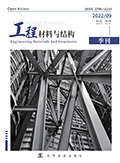

《Smart and Multifunctional Concrete toward Sustainable Infrastructures》书评
(中国五洲工程设计集团有限公司, 北京 100053)
摘要: 《Smart and Multifunctional Concrete toward Sustainable Infrastructures》是智能与多功能混凝土领域的第一部英文专著 (由Springer出版集团出版) , 全书共包含3个部分共24章, 其中第一部分介绍了智能与多功能混凝土的定义、分类、起源与哲学依据; 第二部分详细介绍了22种具体的智能与多功能混凝土, 包括定义、分类、原理、性能与应用; 第三部分讨论了面向可持续基础设施的智能与多功能混凝土未来面临的挑战与应对策略。该著作不仅梳理了智能与多功能混凝土的历史发展脉络, 而且从“熵”角度阐述了智能与多功能混凝土出现的哲学依据, 同时全面介绍了二十余种智能与多功能混凝土以及已有雏形或正快速发展的新型智能与多功能混凝土, 最后对面向可持续基础设施的智能与多功能混凝土面临的挑战进行了系统分析并提出了应对策略与发展框架。该著作可作为土木工程专业特别是混凝土材料与结构方向学生的学习教材, 也可对智能与多功能混凝土领域的研究者和工程师提供指导和参考。
关键词: 混凝土, 智能, 多功能, 可持续基础设施, 书评
引用格式: 刘威. 《Smart and Multifunctional Concrete toward Sustainable Infrastructures》书评[J]. 工程材料与结构, 2023, 2(2): 26-29.
文章类型: 书评
收稿日期: 2023-05-11
接收日期: 2023-05-17
出版日期: 2023-06-28
《Smart and Multifunctional Concrete toward Sustainable Infrastructures》[1](《面向可持续基础设施的智能与多功能混凝土》)是大连理工大学(Dalian University of Technology)的韩宝国(Baoguo Han)教授、大连理工大学(Dalian University of Technology)的张立卿(Liqing Zhang)博士以及大连理工大学(Dalian University of Technology)和哈尔滨工业大学(Harbin Institute of Technology)的欧进萍(Jinping Ou)教授共同撰写的智能与多功能混凝土领域的第一部英文专著。该著作由全球第一大科技图书出版集团Springer“纸电同步”出版发行。
传统工程材料性能单一且既有性能提升趋缓,而材料的制备/加工资源-能源依赖性、制备/加工成本以及回收利用难度不断提高,材料性能的充分挖掘或拓展(比如智能化、多功能化、结构-功能一体化,功能-智能一体化)已成为材料可持续发展的一个重要方向。混凝土是世界用量最大的传统工程材料,其已被应用建造了大量基础设施。混凝土主要被用作结构材料,其优异的力学和耐久性能是基础设施安全可靠服役的保障。但随着基础设施的巨型化、服役环境的多因素耦合和严酷化、使用空间的拓展(如极寒、极热、极干等极端环境、地外等)、建造与环境的协调性(避免资源、能源过度应用、减少环境污染)要求不断提高以及人类生存环境要求不断提升,传统混凝土已无法很好满足基础设施建造/服役过程中的安全性、耐久性、舒适性、智能性、韧性、可持续性(低全寿命成本、低资源消耗、低能源消耗、低环境足迹,特别是低碳排放等)以及优异加工性等多方面的要求,促使其逐步由高强、高性能向智能(即类似生物一样可以对环境具有一定响应能力,比如自感知、自修复、自调整等)与多功能(电、热、声、光等)方向发展。混凝土的智能或功能特性主要通过组成设计、特殊制备工艺、引入功能组分或改变混凝土微观结构等来实现。
尽管一些特定种类的智能与多功能混凝土出现在40~50年前,但是智能与多功能混凝土真正概念的提出是在20世纪80年代末期。随后,智能与多功能混凝土的研究与应用得到了快速发展,智能与多功能混凝土的内涵与外延也在不断扩展,新型智能与多功能混凝土不断出现。为了促进智能与多功能混凝土的进一步发展并推动混凝土建造基础设施的可持续发展,韩宝国教授、张立卿博士以及欧进萍教授在二十余年研究的基础上,吸纳全球该领域的核心科研成果和典型工程应用实例,撰写了著作《Smart and Multifunctional Concrete toward Sustainable Infrastructures》[1]。该著作涵盖了智能与多功能混凝土的理论、技术以及应用,具体包括其设计、制备与加工、测试与表征、性能与调控、机理与模型、在基础设施建造中的应用以及未来发展等。该著作的具体架构如下:第一部分对智能与多功能混凝土进行了总体介绍(General introduction to the smart and multifunctional concrete)(第一章),包括定义、分类以及起源,同时从“熵”的角度阐述了智能与多功能混凝土出现的哲学基础;第二部分介绍了二十二种特定种类的智能与多功能混凝土,包括自密实混凝土(也称自流平混凝土,Self-compacting concrete)(第二章)、自膨胀混凝土(Self-expanding concrete)(第三章)、 自养护混凝土(Self-curing concrete)(第四章)、自成型混凝土(即3D打印混凝土,Self-shaping concrete)(第五章)、自感知混凝土(Self-sensing concrete)(第六章)、自修复混凝土(Self-healing concrete)(第七章)、 自调整混凝土(Self-adjusting concrete)(第八章)、 自阻尼混凝土(Damping concrete)(第九章)、抗爆裂混凝土(Anti-spalling concrete)(第十章)、耐磨混凝土(Wear resisting concrete)(第十一章)、飞机拦阻混凝土(Aircraft arresting concrete)(第十二章)、导电混凝土(Electrically conductive concrete)(第十三章)、 电热混凝土(也称自加热混凝土,Electrothermal concrete)(第十四章)、透光混凝土(Light-transmitting concrete)(第十五章)、 发光混凝土(Light-emitting concrete)(第十六章)、光催化混凝土(Photocatalytic concrete)(第十七章)、电磁波屏蔽/吸收混凝土(Electromagnetic wave shielding/absorbing concrete)(第十八章)、 防辐射混凝土(Radiation shielding concrete)(第十九章)、疏水/超疏水混凝土(Hydrophobic/superhydrophobic concrete)(第二十章)、透水混凝土(Permeable concrete)(第二十一章)、水下不分散混凝土(Nondispersible underwater concrete)(第二十二章) 、储能混凝土(Energy harvesting concrete)(第二十三章);第三部分讨论了智能与多功能混凝土后续发展的挑战与相应部署(Future challenges for continued development and deployment of smart and multifunctional concrete)(第二十四章)。
智能与多功能混凝土是智能与多功能材料及结构领域的重要分支,是混凝土材料与结构领域的前沿方向,热点的选题加上作者在该领域多年的研究沉淀,使该著作具有独特的先进性和深入浅出的新鲜感。著作中不仅系统梳理了智能与多功能混凝土的发展脉络,还从“熵”角度阐述了智能与多功能混凝土出现的哲学依据,更全面介绍了二十余种有了一定研究成果和应用的智能与多功能混凝土,以及处于雏形阶段和正在快速发展中的新种类,内容详实而极具参考价值。著作最后一部分对智能与多功能混凝土应用在可持续基础设施中面临的挑战进行了系统分析,具有前瞻性地提出了应对策略并建立了发展框架,帮助读者扩宽思路提升格局。
该著作不仅可以作为土木工程学科特别是混凝土领域的研究生或本科生教材,而且也可以为相关科研人员、工程师、设计师提供参考。对于其他相关领域(如金属基、陶瓷基、高分子基智能与多功能材料)的研究者和工程技术人员,该著作也具有很好的参考价值。
利益冲突: 作者声明无利益冲突。
[②] 通讯作者 Corresponding author:刘威,celiuwei@163.com
收稿日期:2023-05-11; 录用日期:2023-05-17; 发表日期:2023-06-28
参考文献(References)
[1] Han B, Zhang L, Ou J. Smart and Multifunctional Concrete toward Sustainable Infrastructures[M]. Berlin: Springer, 2017.
https://doi.org/10.1007/978-981-10-4349-9
[2] 王欣悦, 丁思齐, 董素芬, 等. 混凝土可持续发展: 应对碳排放引起气候变化危机[J]. 工程材料与结构, 2022, 1(1): 1-14.
https://doi.org/10.48014/ems.20220728001
Book Review of Smart and Multifunctional Concrete toward Sustainable Infrastructure
(China Wuzhou Engineering Group Corporation Ltd. , Beijing 100053, China)
Abstract: Smart and Multifunctional Concrete toward Sustainable Infrastructures, published by Springer Group, is the first English monograph in the field of smart and multifunctional concrete, which contains 24 chapters organized into 3 parts. The first part introduces the definition, classification, origin, and philosophical basis of smart and multifunctional concrete. The second part describes 22 specific types of smart and multifunctional concrete in detail, including their definitions, classifications, principles, performances, and applications. The third part discusses the current challenges and strategies of smart and multifunctional concrete towards sustainable infrastructures. This monograph not only summarizes the historical development of smart and multifunctional concrete, but also elaborates on the philosophical basis for the emergence of smart and multifunctional concrete from the perspective of “entropy”. At the same time, it comprehensively introduces more than 20 types of smart and multifunctional concrete, as well as new types of smart and multifunctional concrete that have already been prototyped or are undergoing rapid development. Finally, the challenges of smart and multifunctional concrete towards sustainable infrastructure are systematically analysed, and corresponding strategies and development frameworks are proposed. This monograph can be used as a learning material for students majoring in civil engineering, especially in the field of concrete materials and structures, as well as a guidance and reference for researchers and engineers in the field of smart and multifunctional concrete.
Keywords: Concrete, smart, multifunctional, sustainable infrastructures, book review
Citation: LIU Wei. Book review of Smart and Multifunctional Concrete toward Sustainable Infrastructures[J]. Engineering Materials and Structures, 2023, 2(2): 26-29.